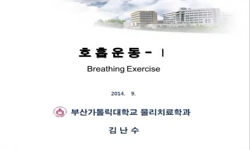Background and Objectives: High aerobic exercise capacity and sport-related physical activity are reported to be inversely associated with arterial stiffness in healthy young adults. However, it is unknown whether increased physical activity and/or hi...
http://chineseinput.net/에서 pinyin(병음)방식으로 중국어를 변환할 수 있습니다.
변환된 중국어를 복사하여 사용하시면 됩니다.
- 中文 을 입력하시려면 zhongwen을 입력하시고 space를누르시면됩니다.
- 北京 을 입력하시려면 beijing을 입력하시고 space를 누르시면 됩니다.



Effects of Physical Activity and Aerobic Exercise Capacity on Aortic Stiffness in Patients With Untreated Hypertension
한글로보기https://www.riss.kr/link?id=A104685658
- 저자
- 발행기관
- 학술지명
- 권호사항
-
발행연도
2009
-
작성언어
English
- 주제어
-
등재정보
KCI등재,SCIE,SCOPUS
-
자료형태
학술저널
- 발행기관 URL
-
수록면
52-56(5쪽)
-
KCI 피인용횟수
4
- 제공처
- 소장기관
-
0
상세조회 -
0
다운로드
부가정보
다국어 초록 (Multilingual Abstract)
Background and Objectives: High aerobic exercise capacity and sport-related physical activity are reported to be inversely associated with arterial stiffness in healthy young adults. However, it is unknown whether increased physical activity and/or high aerobic exercise capacity attenuate arterial stiffness in patients with untreated hypertension.
Subjects and Methods: We studied subjects with never-treated hypertension {n=84 (55 males); mean age±SD, 49±7 years; age range, 36-65 years}. We excluded subjects with a history of diabetes, angina, myocardial infarction, major arrhythmia, or cerebrovascular diseases and those who were taking any cardiovascular medications, including lipid-lowering agents. Carotid intima-media thickness (IMT) and heart-femoral pulse wave velocity (hfPWV) were measured before exercise testing was performed. Physical activity was estimated using a modified Baecke questionnaire. Aerobic exercise capacity was measured with maximal cardiopulmonary exercise testing (maximum oxygen uptake, Vo2max). Results: Linear regression analysis showed a significant inverse correlation between sport-index and hfPWV (r=-0.404; p<0.001), which multiple linear regression analysis showed to be independent of the individual variables of age, gender, body mass index, mean arterial pressure, total cholesterol, fasting blood glucose, and heart rate (beta=-0.277; p=0.004). However, the work- and leisure-indices and Vo2max were not associated with hfPWV (p>0.05). Carotid IMT was not associated with physical activity indices or Vo2max.
Conclusion: In patients with untreated hypertension, increased sport activity was associated with lower aortic stiffness, but high aerobic exercise capacity was not. These results suggest that regular daily exercise, but not exercise capacity, is an important determinant of aortic stiffness in patients with untreated hypertension.
참고문헌 (Reference)
1 배장호, "대한민국 정상인과 위험인자군의 경동맥 내중막 두께:다기관 역학연구" 대한심장학회 35 (35): 513-524, 2005
2 Willum-Hansen T, "Prognostic value of aortic pulse wave velocity as index of arterial stiffness in the general population" 113 : 664-670, 2006
3 Paffenbarger RS Jr, "Physical activity, all-cause mortality, and longevity of college alumni" 314 : 605-613, 1986
4 이무용, "Measurements of Arterial Stiffness: Methodological Aspects" 대한심장학회 38 (38): 343-350, 2008
5 Gates PE, "Left ventricular structure and diastolic function with human ageing: relation to habitual exercise and arterial stiffness" 24 : 2213-2220, 2003
6 Blacher J, "Impact of aortic stiffness on survival in end-stage renal disease" 99 : 2434-2439, 1999
7 Guerin AP, "Impact of aortic stiffness attenuation on survival of patients in end-stage renal failure" 103 : 987-992, 2001
8 Kraft KA, "High aerobic capacity does not attenuate aortic stiffness in hypertensive subjects" 154 : 976-982, 2007
9 Cameron JD, "Exercise training increases total systemic arterial compliance in humans" 266 : H693-H701, 1994
10 Fletcher GF, "Exercise standards for testing and training: a statement for healthcare professionals from the American Heart Association" 104 : 1694-1740, 2001
1 배장호, "대한민국 정상인과 위험인자군의 경동맥 내중막 두께:다기관 역학연구" 대한심장학회 35 (35): 513-524, 2005
2 Willum-Hansen T, "Prognostic value of aortic pulse wave velocity as index of arterial stiffness in the general population" 113 : 664-670, 2006
3 Paffenbarger RS Jr, "Physical activity, all-cause mortality, and longevity of college alumni" 314 : 605-613, 1986
4 이무용, "Measurements of Arterial Stiffness: Methodological Aspects" 대한심장학회 38 (38): 343-350, 2008
5 Gates PE, "Left ventricular structure and diastolic function with human ageing: relation to habitual exercise and arterial stiffness" 24 : 2213-2220, 2003
6 Blacher J, "Impact of aortic stiffness on survival in end-stage renal disease" 99 : 2434-2439, 1999
7 Guerin AP, "Impact of aortic stiffness attenuation on survival of patients in end-stage renal failure" 103 : 987-992, 2001
8 Kraft KA, "High aerobic capacity does not attenuate aortic stiffness in hypertensive subjects" 154 : 976-982, 2007
9 Cameron JD, "Exercise training increases total systemic arterial compliance in humans" 266 : H693-H701, 1994
10 Fletcher GF, "Exercise standards for testing and training: a statement for healthcare professionals from the American Heart Association" 104 : 1694-1740, 2001
11 Sutton-Tyrrell K, "Elevated aortic pulse wave velocity, a marker of arterial stiffness, predicts cardiovascular events in well-functioning older adults" 111 : 3384-3390, 2005
12 Stewart KJ, "Effect of exercise on blood pressure in older persons: a randomized controlled trial" 165 : 756-762, 2005
13 Nelson L, "Effect of changing levels of physical activity on blood-pressure and haemodynamics in essential hypertension" 2 : 473-476, 1986
14 Evenson KR, "Effect of cardiorespiratory fitness on mortality among hypertensive and normotensive women and men" 15 : 565-572, 2004
15 Tabara Y, "Effect of acute and long-term aerobic exercise on arterial stiffness in the elderly" 30 : 895-902, 2007
16 Bots ML, "Common carotid intima-media thickness and risk of stroke and myocardial infarction" 96 : 1432-1437, 1997
17 Boreham CA, "Cardiorespiratory fitness, physical activity, and arterial stiffness" 44 : 721-726, 2004
18 Chambless LE, "Association of coronary heart disease incidence with carotid arterial wall thickness and major risk factors: The Atherosclerosis Risk in Communities (ARIC) study, 1987-1993" 146 : 483-494, 1997
19 Jae SY, "Association between cardiorespiratory fitness and prevalence of carotid atherosclerosis among men with hypertension" 153 : 1001-1005, 2007
20 Mattace-Raso FU, "Arterial stiffness and risk of coronary heart disease and stroke" 113 : 657-663, 2006
21 Kingwell BA, "Arterial compliance may influence baroreflex function in athletes and hypertensives" 268 : H411-H418, 1995
22 Laurent S, "Aortic stiffness is an independent predictor of all-cause and cardiovascular mortality in hypertensive patients" 37 : 1236-1241, 2001
23 Cruickshank K, "Aortic pulse-wave velocity and its relationship to mortality in diabetes and glucose intolerance: an integrated index of vascular function?" 106 : 2085-2090, 2002
24 Tanaka H, "Aging, habitual exercise, and dynamic arterial compliance" 102 : 1270-1275, 2000
25 Ferrier KE, "Aerobic exercise training does not modify largeartery compliance in isolated systolic hypertension" 38 : 222-226, 2001
26 이무용, "Acute and Chronic Effects of Smoking on the Arterial Wall Properties and the Hemodynamics in Smokers with Hypertension" 대한심장학회 35 (35): 493-499, 2005
27 Tanaka H, "Absence of age-related increase in central arterial stiffness in physically active women" 18 : 127-132, 1998
28 Baecke JA, "A short questionnaire for the measurement of habitual physical activity in epidemiological studies" 36 : 936-942, 1982
29 Pereira MA, "A collection of physical activity questionnaires for health-related research" 29 : S5-S9, 1997
30 Mancia G, "2007 guidelines for the management of arterial hypertension: The Task Force for the Management of Arterial Hypertension of the European Society of Hypertension (ESH) and of the European Society of Cardiology (ESC)" 25 : 1105-1187, 2007
동일학술지(권/호) 다른 논문
-
항응고요법을 받는 환자에서 프로쓰롬빈 시간 자가측정기기의 정확성 및 임상적 유용성 평가
- 대한심장학회
- 김성해
- 2009
- KCI등재,SCIE,SCOPUS
-
- 대한심장학회
- 이세원
- 2009
- KCI등재,SCIE,SCOPUS
-
- 대한심장학회
- 오유정
- 2009
- KCI등재,SCIE,SCOPUS
-
급성 전벽부 ST분절 상승 심근경색증 환자에서 P파 분산과 발작성 심방세동의 관계
- 대한심장학회
- 한양천
- 2009
- KCI등재,SCIE,SCOPUS
분석정보
인용정보 인용지수 설명보기
학술지 이력
| 연월일 | 이력구분 | 이력상세 | 등재구분 |
|---|---|---|---|
| 2023 | 평가예정 | 해외DB학술지평가 신청대상 (해외등재 학술지 평가) | |
| 2020-01-01 | 평가 | 등재학술지 유지 (해외등재 학술지 평가) |  |
| 2011-01-01 | 평가 | 등재학술지 유지 (등재유지) |  |
| 2009-01-01 | 평가 | 등재학술지 유지 (등재유지) |  |
| 2008-05-15 | 학회명변경 | 한글명 : 대한순환기학회 -> 대한심장학회영문명 : The Korean Society Of Circulation -> The Korean Society of Cardiology |  |
| 2007-01-01 | 평가 | 등재학술지 유지 (등재유지) |  |
| 2005-08-02 | 학술지등록 | 한글명 : Korean Circulation Journal외국어명 : Korean Circulation Journal |  |
| 2004-01-01 | 평가 | 등재학술지 선정 (등재후보2차) |  |
| 2003-01-01 | 평가 | 등재후보 1차 PASS (등재후보1차) |  |
| 2001-07-01 | 평가 | 등재후보학술지 선정 (신규평가) |  |
학술지 인용정보
| 기준연도 | WOS-KCI 통합IF(2년) | KCIF(2년) | KCIF(3년) |
|---|---|---|---|
| 2016 | 1.13 | 0.34 | 0.71 |
| KCIF(4년) | KCIF(5년) | 중심성지수(3년) | 즉시성지수 |
| 0.45 | 0.36 | 0.52 | 0.12 |




 KCI
KCI






